Leandros Tassiulas
JamShield: A Machine Learning Detection System for Over-the-Air Jamming Attacks
Jul 15, 2025Abstract:Wireless networks are vulnerable to jamming attacks due to the shared communication medium, which can severely degrade performance and disrupt services. Despite extensive research, current jamming detection methods often rely on simulated data or proprietary over-the-air datasets with limited cross-layer features, failing to accurately represent the real state of a network and thus limiting their effectiveness in real-world scenarios. To address these challenges, we introduce JamShield, a dynamic jamming detection system trained on our own collected over-the-air and publicly available dataset. It utilizes hybrid feature selection to prioritize relevant features for accurate and efficient detection. Additionally, it includes an auto-classification module that dynamically adjusts the classification algorithm in real-time based on current network conditions. Our experimental results demonstrate significant improvements in detection rate, precision, and recall, along with reduced false alarms and misdetections compared to state-of-the-art detection algorithms, making JamShield a robust and reliable solution for detecting jamming attacks in real-world wireless networks.
TRACE: Grounding Time Series in Context for Multimodal Embedding and Retrieval
Jun 10, 2025Abstract:The ubiquity of dynamic data in domains such as weather, healthcare, and energy underscores a growing need for effective interpretation and retrieval of time-series data. These data are inherently tied to domain-specific contexts, such as clinical notes or weather narratives, making cross-modal retrieval essential not only for downstream tasks but also for developing robust time-series foundation models by retrieval-augmented generation (RAG). Despite the increasing demand, time-series retrieval remains largely underexplored. Existing methods often lack semantic grounding, struggle to align heterogeneous modalities, and have limited capacity for handling multi-channel signals. To address this gap, we propose TRACE, a generic multimodal retriever that grounds time-series embeddings in aligned textual context. TRACE enables fine-grained channel-level alignment and employs hard negative mining to facilitate semantically meaningful retrieval. It supports flexible cross-modal retrieval modes, including Text-to-Timeseries and Timeseries-to-Text, effectively linking linguistic descriptions with complex temporal patterns. By retrieving semantically relevant pairs, TRACE enriches downstream models with informative context, leading to improved predictive accuracy and interpretability. Beyond a static retrieval engine, TRACE also serves as a powerful standalone encoder, with lightweight task-specific tuning that refines context-aware representations while maintaining strong cross-modal alignment. These representations achieve state-of-the-art performance on downstream forecasting and classification tasks. Extensive experiments across multiple domains highlight its dual utility, as both an effective encoder for downstream applications and a general-purpose retriever to enhance time-series models.
HELM: Hyperbolic Large Language Models via Mixture-of-Curvature Experts
May 30, 2025



Abstract:Large language models (LLMs) have shown great success in text modeling tasks across domains. However, natural language exhibits inherent semantic hierarchies and nuanced geometric structure, which current LLMs do not capture completely owing to their reliance on Euclidean operations. Recent studies have also shown that not respecting the geometry of token embeddings leads to training instabilities and degradation of generative capabilities. These findings suggest that shifting to non-Euclidean geometries can better align language models with the underlying geometry of text. We thus propose to operate fully in Hyperbolic space, known for its expansive, scale-free, and low-distortion properties. We thus introduce HELM, a family of HypErbolic Large Language Models, offering a geometric rethinking of the Transformer-based LLM that addresses the representational inflexibility, missing set of necessary operations, and poor scalability of existing hyperbolic LMs. We additionally introduce a Mixture-of-Curvature Experts model, HELM-MICE, where each expert operates in a distinct curvature space to encode more fine-grained geometric structure from text, as well as a dense model, HELM-D. For HELM-MICE, we further develop hyperbolic Multi-Head Latent Attention (HMLA) for efficient, reduced-KV-cache training and inference. For both models, we develop essential hyperbolic equivalents of rotary positional encodings and RMS normalization. We are the first to train fully hyperbolic LLMs at billion-parameter scale, and evaluate them on well-known benchmarks such as MMLU and ARC, spanning STEM problem-solving, general knowledge, and commonsense reasoning. Our results show consistent gains from our HELM architectures -- up to 4% -- over popular Euclidean architectures used in LLaMA and DeepSeek, highlighting the efficacy and enhanced reasoning afforded by hyperbolic geometry in large-scale LM pretraining.
Ethereum Price Prediction Employing Large Language Models for Short-term and Few-shot Forecasting
Mar 29, 2025Abstract:Cryptocurrencies have transformed financial markets with their innovative blockchain technology and volatile price movements, presenting both challenges and opportunities for predictive analytics. Ethereum, being one of the leading cryptocurrencies, has experienced significant market fluctuations, making its price prediction an attractive yet complex problem. This paper presents a comprehensive study on the effectiveness of Large Language Models (LLMs) in predicting Ethereum prices for short-term and few-shot forecasting scenarios. The main challenge in training models for time series analysis is the lack of data. We address this by leveraging a novel approach that adapts existing pre-trained LLMs on natural language or images from billions of tokens to the unique characteristics of Ethereum price time series data. Through thorough experimentation and comparison with traditional and contemporary models, our results demonstrate that selectively freezing certain layers of pre-trained LLMs achieves state-of-the-art performance in this domain. This approach consistently surpasses benchmarks across multiple metrics, including Mean Squared Error (MSE), Mean Absolute Error (MAE), and Root Mean Squared Error (RMSE), demonstrating its effectiveness and robustness. Our research not only contributes to the existing body of knowledge on LLMs but also provides practical insights in the cryptocurrency prediction domain. The adaptability of pre-trained LLMs to handle the nature of Ethereum prices suggests a promising direction for future research, potentially including the integration of sentiment analysis to further refine forecasting accuracy.
MTBench: A Multimodal Time Series Benchmark for Temporal Reasoning and Question Answering
Mar 21, 2025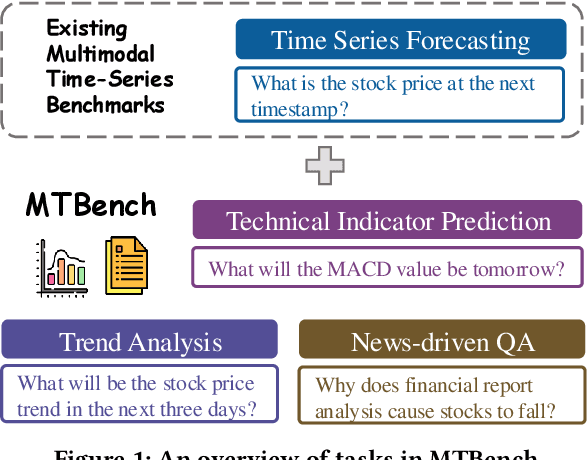

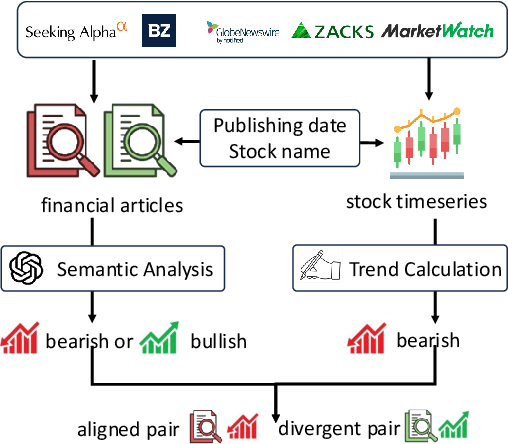

Abstract:Understanding the relationship between textual news and time-series evolution is a critical yet under-explored challenge in applied data science. While multimodal learning has gained traction, existing multimodal time-series datasets fall short in evaluating cross-modal reasoning and complex question answering, which are essential for capturing complex interactions between narrative information and temporal patterns. To bridge this gap, we introduce Multimodal Time Series Benchmark (MTBench), a large-scale benchmark designed to evaluate large language models (LLMs) on time series and text understanding across financial and weather domains. MTbench comprises paired time series and textual data, including financial news with corresponding stock price movements and weather reports aligned with historical temperature records. Unlike existing benchmarks that focus on isolated modalities, MTbench provides a comprehensive testbed for models to jointly reason over structured numerical trends and unstructured textual narratives. The richness of MTbench enables formulation of diverse tasks that require a deep understanding of both text and time-series data, including time-series forecasting, semantic and technical trend analysis, and news-driven question answering (QA). These tasks target the model's ability to capture temporal dependencies, extract key insights from textual context, and integrate cross-modal information. We evaluate state-of-the-art LLMs on MTbench, analyzing their effectiveness in modeling the complex relationships between news narratives and temporal patterns. Our findings reveal significant challenges in current models, including difficulties in capturing long-term dependencies, interpreting causality in financial and weather trends, and effectively fusing multimodal information.
Large-Scale AI in Telecom: Charting the Roadmap for Innovation, Scalability, and Enhanced Digital Experiences
Mar 06, 2025Abstract:This white paper discusses the role of large-scale AI in the telecommunications industry, with a specific focus on the potential of generative AI to revolutionize network functions and user experiences, especially in the context of 6G systems. It highlights the development and deployment of Large Telecom Models (LTMs), which are tailored AI models designed to address the complex challenges faced by modern telecom networks. The paper covers a wide range of topics, from the architecture and deployment strategies of LTMs to their applications in network management, resource allocation, and optimization. It also explores the regulatory, ethical, and standardization considerations for LTMs, offering insights into their future integration into telecom infrastructure. The goal is to provide a comprehensive roadmap for the adoption of LTMs to enhance scalability, performance, and user-centric innovation in telecom networks.
Age Optimal Sampling for Unreliable Channels under Unknown Channel Statistics
Dec 24, 2024Abstract:In this paper, we study a system in which a sensor forwards status updates to a receiver through an error-prone channel, while the receiver sends the transmission results back to the sensor via a reliable channel. Both channels are subject to random delays. To evaluate the timeliness of the status information at the receiver, we use the Age of Information (AoI) metric. The objective is to design a sampling policy that minimizes the expected time-average AoI, even when the channel statistics (e.g., delay distributions) are unknown. We first review the threshold structure of the optimal offline policy under known channel statistics and then reformulate the design of the online algorithm as a stochastic approximation problem. We propose a Robbins-Monro algorithm to solve this problem and demonstrate that the optimal threshold can be approximated almost surely. Moreover, we prove that the cumulative AoI regret of the online algorithm increases with rate $\mathcal{O}(\ln K)$, where $K$ is the number of successful transmissions. In addition, our algorithm is shown to be minimax order optimal, in the sense that for any online learning algorithm, the cumulative AoI regret up to the $K$-th successful transmissions grows with the rate at least $\Omega(\ln K)$ in the worst case delay distribution. Finally, we improve the stability of the proposed online learning algorithm through a momentum-based stochastic gradient descent algorithm. Simulation results validate the performance of our proposed algorithm.
SANDWICH: Towards an Offline, Differentiable, Fully-Trainable Wireless Neural Ray-Tracing Surrogate
Nov 13, 2024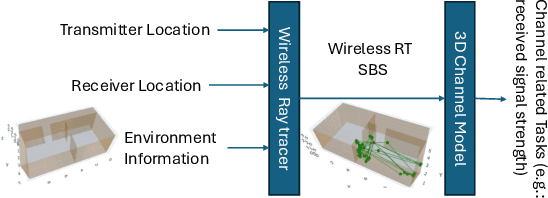
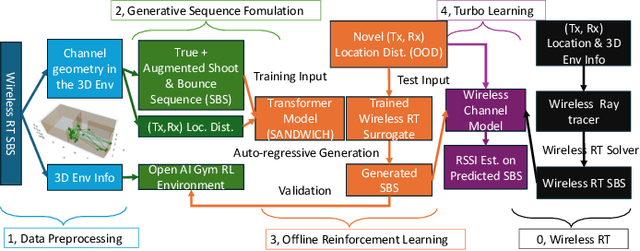
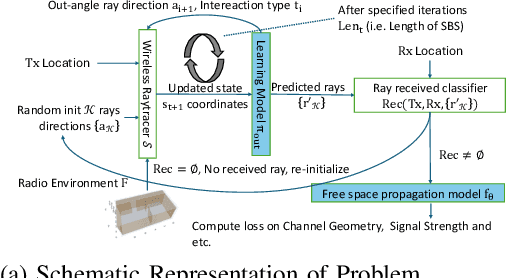

Abstract:Wireless ray-tracing (RT) is emerging as a key tool for three-dimensional (3D) wireless channel modeling, driven by advances in graphical rendering. Current approaches struggle to accurately model beyond 5G (B5G) network signaling, which often operates at higher frequencies and is more susceptible to environmental conditions and changes. Existing online learning solutions require real-time environmental supervision during training, which is both costly and incompatible with GPU-based processing. In response, we propose a novel approach that redefines ray trajectory generation as a sequential decision-making problem, leveraging generative models to jointly learn the optical, physical, and signal properties within each designated environment. Our work introduces the Scene-Aware Neural Decision Wireless Channel Raytracing Hierarchy (SANDWICH), an innovative offline, fully differentiable approach that can be trained entirely on GPUs. SANDWICH offers superior performance compared to existing online learning methods, outperforms the baseline by 4e^-2 radian in RT accuracy, and only fades 0.5 dB away from toplined channel gain estimation.
Long Sequence Modeling with Attention Tensorization: From Sequence to Tensor Learning
Oct 28, 2024



Abstract:As the demand for processing extended textual data grows, the ability to handle long-range dependencies and maintain computational efficiency is more critical than ever. One of the key issues for long-sequence modeling using attention-based model is the mismatch between the limited-range modeling power of full attention and the long-range token dependency in the input sequence. In this work, we propose to scale up the attention receptive field by tensorizing long input sequences into compact tensor representations followed by attention on each transformed dimension. The resulting Tensorized Attention can be adopted as efficient transformer backbones to extend input context length with improved memory and time efficiency. We show that the proposed attention tensorization encodes token dependencies as a multi-hop attention process, and is equivalent to Kronecker decomposition of full attention. Extensive experiments show that tensorized attention can be used to adapt pretrained LLMs with improved efficiency. Notably, Llama-8B with tensorization is trained under 32,768 context length and can steadily extrapolate to 128k length during inference with $11\times$ speedup, compared to full attention with FlashAttention-2.
SplitLLM: Collaborative Inference of LLMs for Model Placement and Throughput Optimization
Oct 14, 2024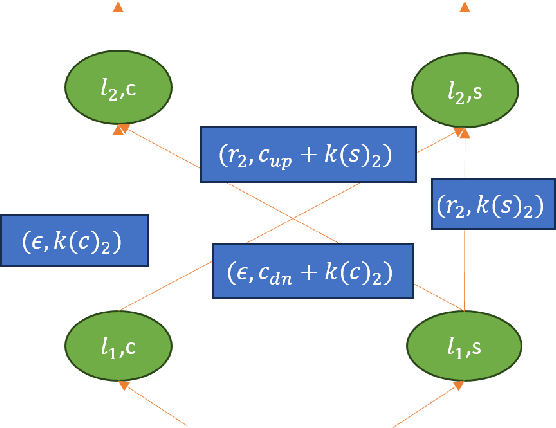
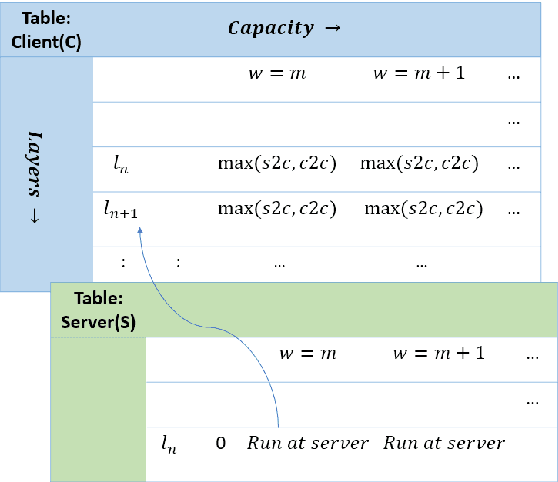
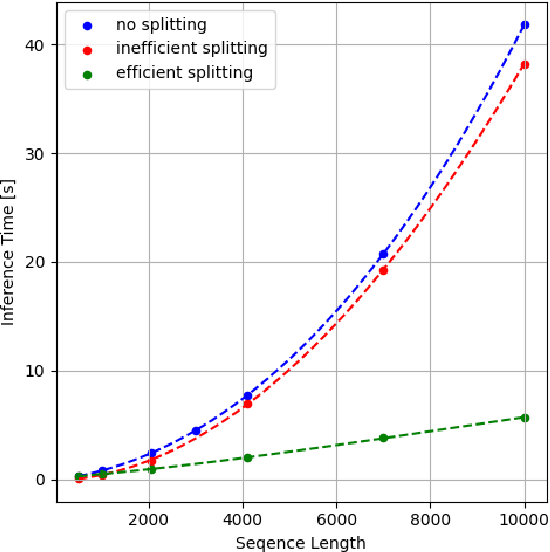
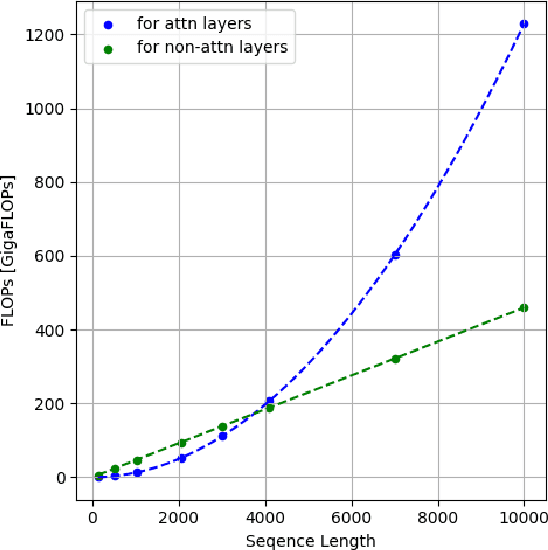
Abstract:Large language models (LLMs) have been a disruptive innovation in recent years, and they play a crucial role in our daily lives due to their ability to understand and generate human-like text. Their capabilities include natural language understanding, information retrieval and search, translation, chatbots, virtual assistance, and many more. However, it is well known that LLMs are massive in terms of the number of parameters. Additionally, the self-attention mechanism in the underlying architecture of LLMs, Transformers, has quadratic complexity in terms of both computation and memory with respect to the input sequence length. For these reasons, LLM inference is resource-intensive, and thus, the throughput of LLM inference is limited, especially for the longer sequences. In this report, we design a collaborative inference architecture between a server and its clients to alleviate the throughput limit. In this design, we consider the available resources on both sides, i.e., the computation and communication costs. We develop a dynamic programming-based algorithm to optimally allocate computation between the server and the client device to increase the server throughput, while not violating the service level agreement (SLA). We show in the experiments that we are able to efficiently distribute the workload allowing for roughly 1/3 reduction in the server workload, while achieving 19 percent improvement over a greedy method. As a result, we are able to demonstrate that, in an environment with different types of LLM inference requests, the throughput of the server is improved.
 Add to Chrome
Add to Chrome Add to Firefox
Add to Firefox Add to Edge
Add to Edge